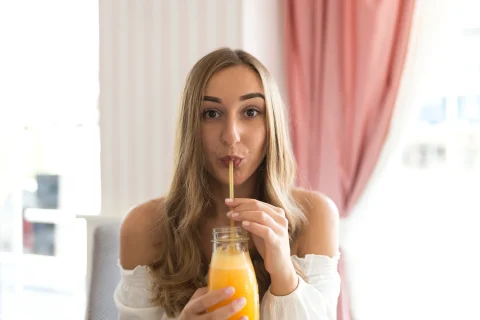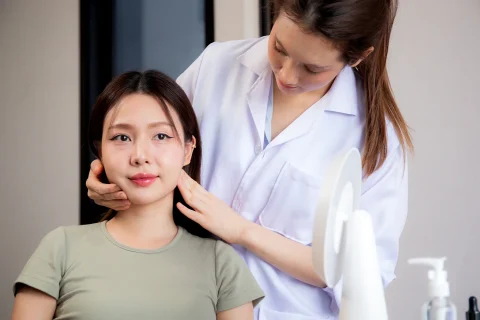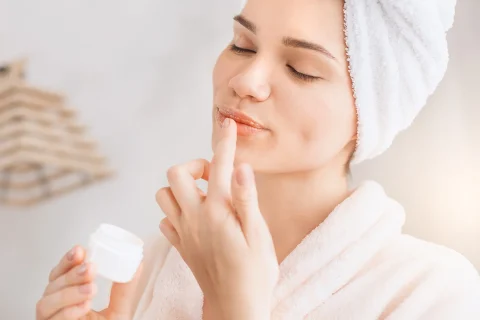Want to minimize lip filler swelling? Discover the best sleep positions and strategies for optimal recovery.
Elevate your head with extra pillows for 1–2 days post-lip filler. Avoid lying flat for at least 4 hours, ideally 6. Do not sleep on your stomach or side. Protect the treated area. Maintain a cool environment, and avoid strenuous activity. A consistent sleep schedule may help optimize healing and minimize swelling.
Recommended Sleeping Position After Lip Fillers

To minimize lip pressure after fillers, lie on your back. This position prevents rubbing and pressing, potentially improving blood flow and lymphatic drainage, thus reducing swelling.
It also helps keep fillers in place, avoiding uneven distribution and discomfort. Avoid sleeping on your stomach or side for at least 1–2 days, as these positions can put pressure on one side of your face, potentially causing uneven swelling.
Using two to three extra pillows to elevate your head and upper body can reduce swelling and improve blood flow. Strategic pillow arrangements, including neck or wedge pillows, can prevent rolling and ensure comfort.
Maintaining lip moisture through hydration can prevent dryness and cracking. These strategies are crucial for optimal healing after lip fillers.
Preparation Before Sleep
Minimize post-treatment swelling and maximize lip filler results by strategically preparing for sleep.
Avoid lying down for 4-6 hours after treatment. Refrain from strenuous activity, smoking, and vaping for 24 hours. Maintain adequate hydration.
Keep your nighttime environment cool; avoid hot showers and steam. Don’t consume alcohol for 48 hours post-treatment.
Apply cold compresses. Limit spicy foods. Minimize lip movement, touching, and makeup application.
Elevate your head with extra pillows to aid lymphatic drainage. Use a silk or satin pillowcase to reduce friction.
Practice relaxation techniques to promote better sleep. These pre-sleep practices may optimize healing and contribute to reduced swelling from lip fillers.
Products to Aid Sleep After Getting Lip Fillers

Elevate your head with extra pillows to reduce swelling and improve blood flow after lip fillers. Wedge pillows support proper upper body position. Neck pillows maintain head and face alignment.
Silk or satin pillowcases minimize skin irritation. Position pillows to prevent rolling onto your treated lips.
Moisturize your lips with lip balm or cream before bed to prevent dryness, which is crucial for recovery. Drinking plenty of water and eating fruits and vegetables may decrease swelling.
Avoid applying pressure or engaging in activities that press on your lips. Cold compresses can lessen swelling and discomfort.
A humidifier might create a more comfortable, less dry atmosphere for better sleep. These strategies can optimize sleep quality and recovery.
General Aftercare Tips During Sleep After Lip Fillers
After lip filler treatment, prioritize sleep positions that minimize swelling.
Lie on your back, elevating your head with extra pillows. Avoid sleeping on your stomach or side for at least the first 24 hours. Use pillows to create a supportive head cradle, preventing movement. A wedge pillow can also maintain elevation.
Allow at least 4-6 hours for the filler to settle before sleep. Refrain from touching your lips for 6 hours. Employ pillows to maintain proper alignment, keeping your head elevated, and preventing rolling over.
Aim for 7-9 hours of sleep for optimal healing. Relaxation techniques before bed may aid the healing process. Manage pressure on your face, especially within the first 48 hours.
Contact your practitioner if significant changes or discomfort arise. Follow your practitioner’s specific post-treatment sleep care instructions.
Managing Swelling and Discomfort
Managing lip filler swelling and discomfort is essential for optimal healing. Effective strategies can drastically reduce swelling and alleviate pain.
| Technique | Action | Potential Benefits |
| Elevation | Position head elevated with pillows; avoid applying pressure. | Reduces swelling, improves circulation. |
| Cold Therapy | Apply cold compresses to lips, avoiding direct contact. | Potentially slows blood flow, reducing swelling and bruising. |
| Pain Relief & Relaxation | Use over-the-counter pain relievers; practice deep breathing or meditation. | Helps manage discomfort and improve sleep quality. |
Adhere strictly to post-treatment instructions. Refrain from rubbing or touching your lips. Choose comfortable sleep positions that minimize pressure on your lips to lessen swelling. Maintaining good hydration and a healthy diet, avoiding hot or spicy foods, is important.
Monitor any changes and consult your practitioner if needed. These strategies significantly enhance the healing process.
Important Considerations for Sleep After Treatment
Optimize lip filler recovery by prioritizing sleep. Proper sleep duration and position directly influence healing.
Sleeping on your back minimizes pressure on the lips, promoting reduced swelling. Elevating your head with pillows facilitates better blood circulation, aiding in the healing process. Avoiding stomach or side sleeping for a few days may prevent filler migration.
Aim for 7-9 hours of sleep nightly; this supports the body’s natural healing responses and can contribute to reducing swelling and inflammation. Maintaining good sleep hygiene further strengthens your body’s ability to heal.
These strategies, combined with other post-treatment care instructions, are likely to improve results and minimize potential complications.
Long-Term Considerations
Maintain desired results by establishing consistent sleep habits.
- Gradually resume normal sleep routines within a few weeks, but avoid side or stomach sleeping for roughly two weeks to minimize filler migration.
- Elevating your head for a few additional weeks helps ensure optimal filler placement and can potentially reduce long-term issues.
- Using silk pillowcases and lip balm protects the delicate lip area.
- Regularly monitor any changes and consult your practitioner for any concerns.
These practices support proper filler integration, leading to improved long-term outcomes.
Consistent care is essential for optimal filler maintenance.
Avoiding Irritation
To minimize lip filler irritation, adopt sleeping positions that alleviate pressure. Sleeping supine (on your back) is optimal. Avoid sleeping on your stomach or side for at least 1-2 days post-procedure.
Optimize healing by:
- Elevating your head with extra pillows to enhance circulation.
- Employ body pillows or side pillows to prevent turning.
- Choose silk or satin pillowcases to reduce friction.
- Select smooth bedding to prevent irritation.
Proper pillow selection and good sleeping posture are essential for optimal healing.
Maintain hygiene and follow your healthcare provider’s post-treatment instructions.
Dietary Guidelines for Sleep

Proper nutrition significantly impacts sleep quality; irregular eating habits or poor food choices can interfere with sleep.
Prioritize sleep-promoting foods, like tart cherries, kiwi, fatty fish, milk products, and pumpkin seeds. Time your meals strategically; avoid eating close to bedtime, and maintain regular mealtimes.
Limit simple carbohydrates and sugary foods at least four hours before sleep. A balanced diet, rich in protein, whole grains, fruits, and vegetables, promotes better sleep.
Focus on meals with lower saturated fat and higher protein content before bed. Avoiding alcohol and caffeine several hours before sleep is crucial.
These dietary strategies, especially meal timing, can substantially improve sleep quality. For example, incorporating foods high in tryptophan, a precursor to melatonin, may aid sleep onset and duration.
Research suggests that eating a balanced meal approximately 3-4 hours before bed can lead to improved sleep.
Post-Treatment Activity Restrictions
Following lip filler treatment, immediate activity restrictions are crucial for optimal healing. Adherence to these guidelines significantly impacts the recovery process.
For best results, prioritize these steps:
- Avoid lying down or sleeping for at least 4-6 hours post-treatment to allow the filler to settle.
- Refrain from touching or rubbing the treated lips for at least 6 hours to prevent disruption.
- Avoid hot liquids and spicy foods to minimize increased blood flow to the treated area.
- Limit intense physical activity for at least 24-48 hours to reduce swelling and bruising. This time frame may need adjustment based on individual response.
Prioritizing proper post-treatment activity is key for a positive outcome.
Elevated and appropriate sleeping positions, along with avoiding potentially harmful activities, will likely facilitate a faster recovery.
Final Thoughts

Optimize your sleep and healing after lip fillers by strategically managing your position, minimizing pressure points, and actively addressing swelling. Avoid vigorous exercise; a healthy diet may accelerate recovery.
A consistent aftercare regimen significantly improves outcomes and minimizes potential problems. Individual responses vary; consult your injector for personalized guidance. Proper positioning, for example, elevating your head with a few pillows, may alleviate discomfort and encourage optimal healing.










